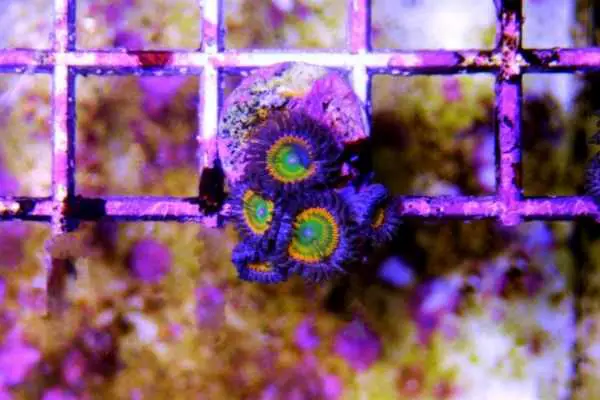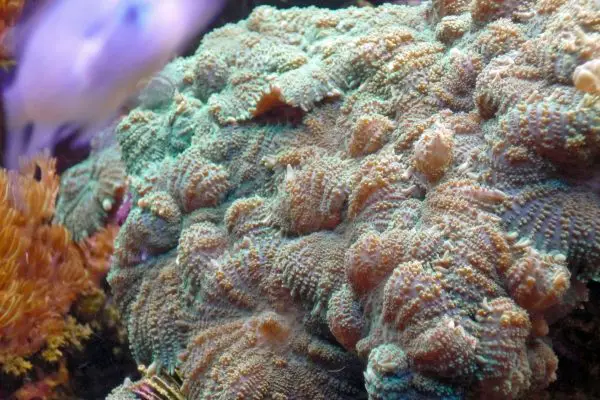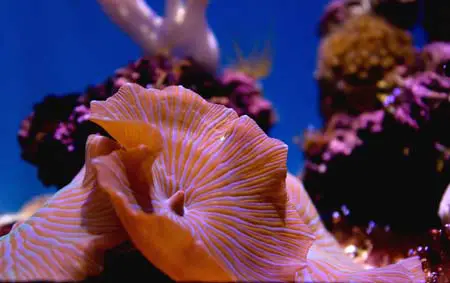Do you keep soft corals in your aquarium? Have you ever bought a coral frag from your local fish store or a fellow hobbyist and wondered where it came from? Have you wondered how to frag coral in your aquarium but weren’t sure where to start? Then you’ve come to the right place! We’ll go over the basics for beginners and give you a solid foundation to get started on the right foot.
Table of Contents: How to Frag Coral
There’s nothing more exciting for a new hobbyist than learning how to frag coral. And you probably want to jump straight to the process. But if you’re new to the idea (and how things work), you may want to read through the entire article rather than bouncing down to the step-by-step guide with the link below. But the choice is yours (you know – that whole internet and free-will thing).
- What Are Coral Frags?
- How to Frag Coral
- Choosing a Species (For Beginners)
- Materials to Frag Coral
- Steps to Frag Coral
- For More Information

What Are Coral Frags?
Whenever you set up a reef tank, you start to hear aquarists discuss their favorite techniques of how to frag corals. And when you hit your favorite fish retailers? You’ll see coral frags up for sale. A coral frag is a term for a coral fragment. And that’s exactly what they are: small pieces of the original colony. It’s only when the frag reaches a standard size (typically, when it’s expanded past the original “plug”) that you stop referring to it as a “frag.”
The frag plug refers to the substrate a coral frag rests on while it’s growing. You CAN purchase official frag plugs. But pieces of “rubble” you have lying around your saltwater aquarium work equally well. And when you’re starting out as a beginner learning to frag coral? You probably don’t need to rush out and attempt to set up a coral-growing business.
Coral frags are popular because they don’t cost as much as a full-grown colony. And when you start to frag corals on your own, you get to see them grow. It’s impressive to watch a tiny piece flourish into a magnificent creature.
How to Frag Coral
When you frag coral, you’re cutting, breaking, or otherwise sub-dividing a coral colony. It may seem harsh to break apart corals, but they’re genetically programmed to survive and even flourish in these conditions. Newly formed coral embryos successfully grow after being fragmented in laboratory experiments. Reproducing and growing via fragmentation is in their DNA.
The coral actually does the hard part (healing, settling, reorganizing, and growing). You assist by initiating the fragmentation. You then “plant” your pieces onto frag plugs that provide a stable surface for the coral piece to adhere to. (You can also use your live rock if you’d rather) And then they take over the work by growing as they would normally. You don’t even need to worry about special water conditions. Coral frags require the same lighting and flow conditions as the “parent.”
There’s no “pain” involved when you frag coral. Again, the fragmentation process is natural. Plenty of corals undergo breakage in rough seas during hurricanes and other storms. This asexual reproduction technique allows them to colonize new places on the reef. You’re taking the place of Mother Nature within your saltwater tank.

Choosing a Species (For Beginners)
Once you have the hang of things, you can frag ANY coral. But if you’re starting out and brand new to the process? You probably want to ease yourself in. While breaking can occur in your tank due to the activities of your fish and invertebrates – providing you with a handy frag – you want to get more precise with the process. And that means choosing a species you can manage.
LPS corals are a good choice to frag because they’re fairly easy to break apart, especially the branching varieties. But, overall, you want intermediate skills to keep most of the LPS species. Because of that, I’m going to make a slightly different recommendation for the beginner looking to frag coral.
If this is your first time fragging coral, one of the easiest specimens to start with belongs to the group of corals commonly called mushroom corals. These guys grow on rocks as individual large, fleshy polyps. They routinely reproduce themselves either by splitting (a process where the polyp forms two mouths and eventually divides down the middle) or by budding (a piece of the foot pinches off and forms a new polyp). Both are simple processes that result in the FAST growth of the species through your tank.
In my experience, any sliver of mushroom coral can and WILL reproduce a new polyp. It doesn’t matter where it’s cut from or how small the piece may be. This is why I recommend mushrooms as a first–choice for beginners looking to frag coral.

One note of caution: you should NEVER try to frag newly purchased corals! Give them time to acclimate to your aquarium conditions for a couple months, UNDISTURBED before considered fragging. Once you feel certain the coral is growing well and thriving within the tank, THEN you can move forward with your plan to frag coral.
Materials to Frag Coral
You’ve settled on a mushroom coral as your first foray in an experiment to frag coral. You allowed your chosen specimen to grow in your aquarium for several months. It’s happy, healthy, and it’s grown. But you’d like to start a new colony in a new section of the tank. Or maybe a friend’s admired the color or pattern you have. You want to get started fragging. And that means you’ll want to gather the following materials FIRST:
- Brand NEW razor blade
- Small bowl
- Piece of live rock rubble or a frag plug
- A small plastic mesh patch (from a bag of fruit, wedding veil material from a fabric store, etc.)
- Rubber band
- Reef glue

Steps to Frag Coral
When you’re ready to frag coral, set up an area to work. Obviously, you will be handling a WET coral, so you want to lay down paper towels over your work surface to prevent a massive splash zone. And since you’ll be wielding a razor blade? It’s not a bad idea to have a stash of band-aids at the ready. (Hey, accidents happen) Even if you’re NOT a beginner, you should still come prepared for the worst.
Okay, ready to frag coral? Then let’s go!
- Pull out the rock the coral is attached to. You don’t want to frag the coral in your tank. You won’t have much room to work, and you’ll stress your fish and invertebrates in the process. Set the rock on your towels to minimize the mess.
- Take the razor blade and slice off a piece of the coral. As I mentioned before, almost any piece will do. My preferred “method” (if you can call it that) is to cut the entire cap off the coral. Slice horizontally across the stalk, leaving the foot (the part of the coral stuck to the rock) behind.
- Fill the small bowl with aquarium water and drop the coral frag inside. You’ll likely see some white stringy material hanging from the fresh-cut fragment, and you’ll see brown ooze, as well. Don’t worry – this is a natural response from the mushroom coral to an injury.
- After a brief dip in the bath, take the frag out of the water and place it on the live rock piece (outside the bowl). Dump the fouled water.
- Wrap the live rock and frag with the plastic mesh, holding it in place with the rubber band.
- Gently place the coral frag in an area of your tank with low flow and return the rock with the parent colony to its original location in your tank.
- Wait (this is the second hardest part).
- After some time, you’ll notice the damaged stalk growing a new discoid-shaped head. Meanwhile, the frag will attach to the live rock piece.
- Once your frag has settled and attached, you can safely remove the plastic mesh and glue the chunk of rock to the final location in your aquarium.
Congratulations! You completed your first attempt to frag coral! (It’s really that easy) Now you can trade that frag with a fellow hobbyist and share this article with them, so they can do the same thing.
For More Information
Sounds too simple and good to be true, doesn’t it? Maybe you’d like a little more information on how to frag corals. Not to worry – I’ve got you covered.
This YouTube video will walk you through the process to frag coral (so you can pause and restart, as needed):
I also wrote a book about this topic, titled (you guessed it) How to Frag Corals. So when you feel like you’re ready to move on from mushroom corals? You’ll have the perfect reference guide.
Or maybe you want to find out more about fragging, in general. No problem:

Leave a Reply